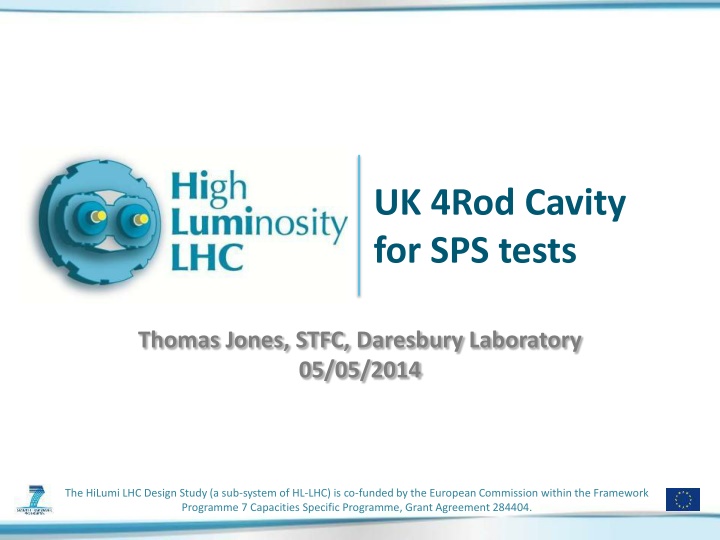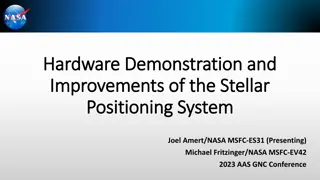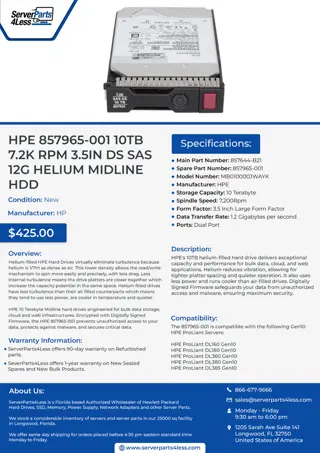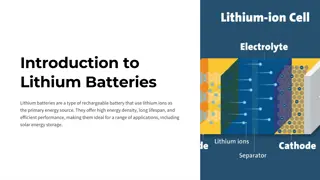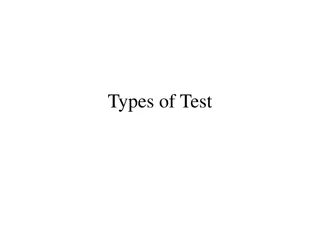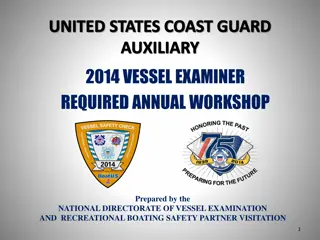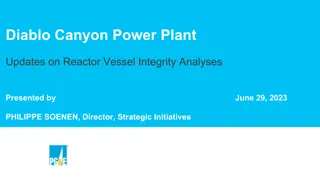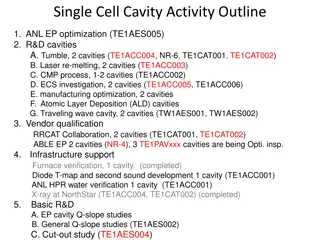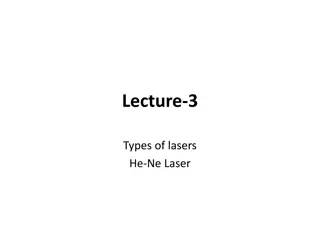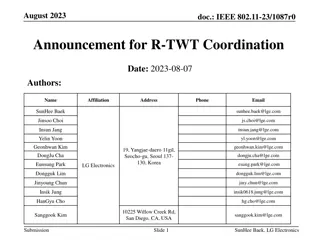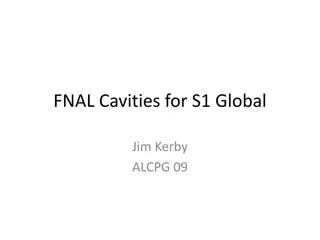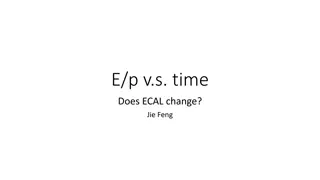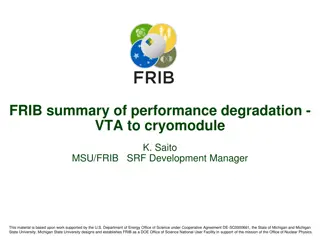UK 4Rod Cavity for SPS Tests - Helium Vessel Design and Manufacture
The UK 4Rod Cavity project involves the design and manufacture of a helium vessel for SPS tests. The project details the conceptual design, vessel manufacture, couplers, tuning processes, and supporting components. Key features include titanium components, stiffening ribs, bellows for tuning flexibility, and various absorbers. The project is part of the HiLumi LHC Design Study and is co-funded by the European Commission.
Download Presentation

Please find below an Image/Link to download the presentation.
The content on the website is provided AS IS for your information and personal use only. It may not be sold, licensed, or shared on other websites without obtaining consent from the author.If you encounter any issues during the download, it is possible that the publisher has removed the file from their server.
You are allowed to download the files provided on this website for personal or commercial use, subject to the condition that they are used lawfully. All files are the property of their respective owners.
The content on the website is provided AS IS for your information and personal use only. It may not be sold, licensed, or shared on other websites without obtaining consent from the author.
E N D
Presentation Transcript
UK 4Rod Cavity for SPS tests Thomas Jones, STFC, Daresbury Laboratory 05/05/2014 The HiLumi LHC Design Study (a sub-system of HL-LHC) is co-funded by the European Commission within the Framework Programme 7 Capacities Specific Programme, Grant Agreement 284404.
Contents Helium vessel conceptual design Vessel manufacture Couplers Thermal contraction Pressure Tuning Lorentz force detuning 2
Helium vessel conceptual design Inter-cavity support connection Input coupler port Stiffening ribs Gr 2. Titanium to 316 stainless steel transition piece Helium Vessel made from Grade 2 Titanium Additional beam tube required for LHC installation 312mm Cryoperm (magnetic shield) 194mm 550mm UK 4 Rod Cavity Modified Saclay II tuner 3
LOM coupler port Titanium bellows to allow cavity compression when tuning Vertical HOM coupler port Nb-Ti transitions e- beam welded during cavity manufacture. Bare cavity prior to He vessel installation Cavity stiffening ribs with 3 titanium vessel connections to reduce tuning force on ports Rectangular flange required for tuner. 4
Vessel Manufacture Bent 6mm thick Grade 2 Ti sheet All joints in Helium vessel to be TIG welded Bellows for tuning flexibility 10mm thick Grade 2 Titanium End plates Dummy Beam pipe for LHC 40mm deep x 10mm thick Grade 2 Ti Stiffening ribs 30mm thick Grade 2 Ti Mounting blocks for tuner 5
Cavity String FPC support system Fundamental Power Coupler LOM absorber Cavity in Helium Vessel End lever tuning system 1mm thick Cryoperm magnetic shielding Inter-cavity support Horizontal HOM absorber Total mass supported by outer wall of FPC = ~250Kg In vacuum all metal valve Vertical HOM absorber 2K 300K transition bellows with 80K intercept Further details in my Cryomodule presentation tomorrow 6
HOM Couplers Could drill here to give additional cooling if required 2-Phase Out LHe bottom fill Horizontal HOM coupler Less cooling required therefore copper strapping will be used from outer conductor to cavity Helium vessel 2 holes require slotting to give access for bolts Vertical coupler 7
Horizontal HOM Outer conductor attached to cavity is fixed at 2K Inner conductor Rs=5 n Ohms All else Rs=200 n Ohms No static load included, assume cable will be sufficiently long and have 80K intercept to reduce heat leak to a minimum
Vertical HOM Outer conductor attached to cavity is fixed at 2K Inner conductor and 2nd outer conductor Rs=5 n Ohms All else Rs=200 n Ohms No static load included, assume cable will be sufficiently long and have 80K intercept to reduce heat leak to a minimum
Low order mode coupler Connection to CERN cable (details to be added) Various thickness gaskets can be used here to account for cooldown/manufacturing tolerances. A clamp will be used here to give tuning Tubes used for stubs to give additional cooling 2-Phase Out LHe bottom fill Copper straps could be used from He bath to outer can, if required 10
LOM coupler inner Outer conductor in location of helium vessel is fixed at 2K Assume far end is at 40K due to static loads through cable. Inner conductor Rs=200nOhms which represents the worst case resistance.
LOM coupler Outer conductor in location of helium vessel is fixed at 2K Assume far end is at 40K due to static loads through cable. Inner conductor Rs=200nOhms which represents the worst case resistance.
Thermal Stress Analysing contraction during cool down from room temperature to operation, 295K to 2K Maximum Stress Intensity = 150MPa at cavity side wall rib interface Maximum Deformation = 0.87mm which agrees with integrated L values. Nb-Ti flange used, stress if using 316LN SS is far higher (~400MPa)
Pressure vessel analysis Mesh, Load and Boundary conditions CF flanges and 2 phase line removed to simplify FEA. Fixed in all directions/rotations Outer He vessel modelled as Grade 2 Titanium Young s modulus 113GPa Poisson s ratio 0.342 Cavity modelled as Niobium Reactor grade Type 1, UNS R04200. Young s modulus 100GPa, Poisson s Ratio 0.4 0.18MPa applied to all internal surfaces, to simulate a 1.8 Bar (abs) required by CERN safety code. Bellows removed to simplify analysis. Stainless steel tuner representation 14
Pressure vessel analysis Results Max General Primary Stress is 48MPa in the cavity and max Local Primary Stress is 55MPa in the ports. Both comply with BS EN 13458-2 (A1) regarding Elastic Stress analysis of Cryogenic Vessels for operating conditions. Largest deformation in cavity 0.47mm (shown below). RF simulations show 70KHz per mm deflection in this region, therefore cavity pressure sensitivity is 18Hz/mbar. ((0.47/1.8) x 70) The maximum stress in the model is 122MPa but this occurs in the Grade 2 Titanium vessel which has a Yield Strength of 275MPa (Allowable 183MPa). The largest deformation at 1.8bar (abs) in the Ti vessel is 1.45mm. Ref : BS EN13458-2:2002 Cryogenic Vessels Design, fabrication, inspection & testing15
Tuning with Saclay II design Modified Saclay II tuner installed on DICC module built at Daresbury. Stiffness test of modified Saclay II design at Daresbury. Experience with tuner and piezo active tuning system gained on Daresbury International Collaborative Cryomodule project. Current tuner design tested to 7KN with ~25 m average deflection. Tuner has been modified to increase stiffness for increased width. 8 Without piezo feedback RMS detuning = 2.77 Hz Peak-to-peak ca. 12.29 Hz Filter settings: 1 Order elliptical low pass Lower frequency: 30 Hz Upper frequency: 45 Hz Damping factor: -40 dB 6 Turn off piezo control Feedback DC Gain = 28 4 Detuning (Hz) With piezo feedback RMS detuning = 0.51 Hz Peak-to-peak 2.67 Hz 2 0 -2 -4 -6 Above images ref: Oliver Kugeler, ERL07, Daresbury, May 21-25 0 2 4 6 8 10 12 14 16 18 20 Time (sec) 16
Tuning with Saclay II design Modified Saclay II tuner installed on DICC module built at Daresbury. Stiffness test of modified Saclay II design at Daresbury. Experience with tuner and piezo active tuning system gained on Daresbury International Collaborative Cryomodule project. Current tuner design tested to 7KN with ~25 m average deflection. Tuner has been modified to increase stiffness for increased width. 8 Without piezo feedback RMS detuning = 2.77 Hz Peak-to-peak ca. 12.29 Hz Filter settings: 1 Order elliptical low pass Lower frequency: 30 Hz Upper frequency: 45 Hz Damping factor: -40 dB 6 Turn off piezo control Feedback DC Gain = 28 4 Detuning (Hz) With piezo feedback RMS detuning = 0.51 Hz Peak-to-peak 2.67 Hz 2 0 -2 -4 -6 Above images ref: Oliver Kugeler, ERL07, Daresbury, May 21-25 0 2 4 6 8 10 12 14 16 18 20 Time (sec) 17
Saclay II design integration Ribs support He vessel under tuning loads Piezo units The cavity has been thinned in certain regions to increase tuning range and limit the force required by the tuners whilst remaining within the pressure code. Eccentric cam Tuner width increased to suit He Vessel geometry Stepper motor in its own magnetic shield Studs between tuner and flange can be used to allow for thermal contractions. 18
Tuning analysis Mesh, Load and Boundary conditions Fixed in all directions/rotations Top wall not shown for clarity, but used for FEA. 3500N applied here 7000N applied here Active tuning is only in one direction as Piezos need to always be in compression. Material properties at 2K used 3500N applied here 19
Tuning analysis Results The maximum stress intensity with 7kN load is 117.6 MPa. The FERMILAB Summary of Niobium material properties states that the acceptable stress limit for Nb at 2K is 137MPa. The danger with using this limit is that if the tuner sticks at cryogenic temperatures when the module warms up and the yield stress of Nb returns to 75MPa the cavity will be plastically deformed. This, however, may not be a disadvantage as it can be used to permanently tune the cavity. The total deformation is 0.69mm. This 10.1kN/mm. result gives a cavity stiffness of 20
Tuning analysis Results 7000N on Tuner frame gives 21.5 m maximum deformation. Maximum lateral movement is 647 m. This reduces to 625 m once the tuner stiffness is considered. Tuner stiffness is 320kN/mm. Frequency tuning was studied in a simplified model. The frequency shift per mm of transverse offset is 0.3 MHz/mm so tuning range with current design is +188 kHz. Tuning range required by specification is +/- 60kHz, therefore this design is acceptable with some additional capacity. 22
Lorentz force detuning 303 Nm2 at Vt=1.21 MV therefore ~2380Nm2 at operating voltage of 3.4 MV. Most of the force is at the tip of the rod with some at the base, the force on the outer can is negligible. The force acts upon geometrically stiff regions therefore the Lorentz detuning of the cavity is very low at +408Hz. Rods deform by 0.318 m due to Lorentz forces The detuning is within the cavity bandwidth and resolution of the tuner. 24
Conclusions and Further work The concept for the dressed UK 4 Rod cavity has been further developed. The concept uses a TIG welded grade 2 Titanium Helium tank with Nb-Ti transition pieces e-beam welded to the cavity. This is to minimise stress induced on cool down but also has the advantage of saving weight, therefore minimising the load on the cavity string support. Concepts for HOM and LOM couplers have been developed and initial thermal calculations performed. Losses are very low therefore cooling the couplers should not be an issue. Interfaces with CERN COAX cable need to be added. The cavity has been reinforced, and is therefore now suitable for 1.8 bar CERN pressure requirements. Cavity pressure sensitivity is 18Hz/mbar. The cavity has been optimised for tuning and initial analysis shows that the use of a modified Saclay II type tuner is viable. The anticipated tuning range is +188kHz which meets specification. Lorentz force detuning is low at 408Hz which is within the cavity bandwidth and tuner resolution. 25
